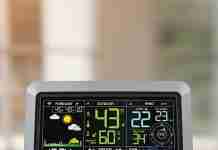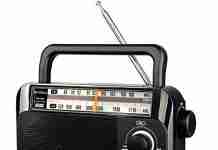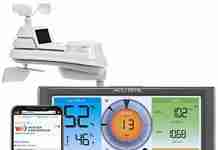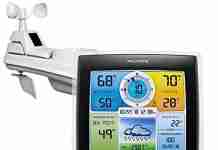Imagine being able to contribute to weather forecasting services from the comfort of your own home. Picture yourself as a citizen scientist, collecting valuable weather data from your personal weather station and sharing it with the world. In this article, we explore the possibility of connecting your home weather station data to weather forecasting services, empowering individuals like us to play a role in improving accuracy and precision in weather predictions. So, grab your rain gauge and anorak, and let’s discover how our passion for weather can make a difference.
Review contents
Benefits of Connecting Home Weather Station Data to Weather Forecasting Services
Enhanced Accuracy
Connecting your home weather station data to weather forecasting services enhances the accuracy of the forecasts. By integrating real-time data from your own weather station, these services are able to gather more precise and localized information. This ensures that the forecasts take into account the unique conditions of your specific location, rather than relying solely on data from distant weather stations.
Real-Time Updates
Connecting your home weather station data to forecasting services allows you to receive real-time updates on weather conditions. Instead of relying on forecasts that may be hours or even days old, you can access the latest information collected by your own personal weather station. This provides you with up-to-the-minute data and allows you to make more informed decisions about outdoor activities or any necessary precautions.
Detailed Local Forecasts
By connecting your home weather station data, you gain access to detailed local forecasts. Traditional weather services often provide forecasts for larger regions, which can overlook the unique microclimates that exist within a given area. However, with home weather station data, you receive forecasts that are specifically tailored to your precise location. This increased level of detail allows for better planning and preparation.
Contribution to Weather Research
Connecting your home weather station data to forecasting services also enables you to contribute to weather research. By sharing your data with meteorologists and scientists, you become part of a larger network that collects and analyzes weather information. This collective data helps improve weather models and forecasting algorithms, leading to more accurate predictions in the future.
Improved Decision-Making
Access to real-time and accurate weather data through your home weather station connection empowers you to make better-informed decisions. Whether you are planning outdoor activities, managing a farm, or simply looking to dress appropriately for the day, having reliable and local weather information ensures that your decisions align with the current weather conditions. This can save you time, money, and hassle in the long run.
Customized Alerts
Connecting your home weather station to forecasting services allows you to receive customized alerts. These alerts can be tailored to the specific weather conditions and events that matter most to you. Whether you want to be notified of rain, thunderstorms, or extreme temperature changes, you can set up alerts to ensure you are prepared and informed at all times.
Integration with Other Smart Home Devices
Another benefit of connecting your home weather station to forecasting services is the ability to integrate with other smart home devices. By linking your weather data to your smart home system, you can automate various tasks based on current and predicted weather conditions. For example, you can program your sprinkler system to only activate when rain is not expected or adjust your thermostat based on upcoming temperature changes.
Sharing Weather Data with Community
Connecting your home weather station data to forecasting services allows you to share your data with the broader community. By contributing your localized weather information, you help improve the accuracy of forecasts for your neighbors and other nearby areas. This collaborative approach to weather monitoring fosters a sense of community and promotes collective efforts in understanding and adapting to changing weather patterns.
Educational Purposes
Connecting your home weather station data to forecasting services can also serve educational purposes. By actively participating in weather monitoring and prediction, you gain firsthand knowledge and experience in meteorology. This can be particularly beneficial for students, weather enthusiasts, or anyone interested in learning more about weather patterns and forecasting methods.
Being Part of a Global Weather Network
When you connect your home weather station data to forecasting services, you become part of a global weather network. Your data contributes to the larger pool of information used by meteorologists and researchers around the world. By sharing your data, you actively participate in a global effort to advance weather forecasting capabilities and improve our understanding of the Earth’s climate system.
Types of Home Weather Stations
Basic Weather Stations
Basic weather stations typically consist of a thermometer, hygrometer, barometer, and anemometer. These stations provide basic weather measurements such as temperature, humidity, air pressure, and wind speed. They are relatively simple to set up and are suitable for those who are new to home weather monitoring or have basic weather monitoring needs.
Advanced Weather Stations
Advanced weather stations offer a wider range of sensors and features for more comprehensive weather monitoring. In addition to the basic measurements provided by the basic weather stations, advanced stations may include sensors for rainfall, UV index, solar radiation, and soil temperature. These stations often have more advanced data logging and connectivity capabilities, allowing for more detailed analysis and integration with forecasting services.
Integrated Smart Home Systems
Integrated smart home systems combine weather monitoring with other home automation features. These systems provide not only weather data but also the ability to automate various tasks based on weather conditions. For example, an integrated smart home system can automatically close the windows when it starts to rain or adjust the indoor temperature based on the outdoor temperature changes. These systems require more advanced setup and may involve additional hardware and software integration.
Compatibility Requirements
Internet Connectivity
To connect your home weather station data to forecasting services, you will need a stable internet connection. This allows your weather station to transmit data to the forecasting service in real-time. Make sure your home weather station and internet router are within range and properly connected.
Data Format
Different weather stations may use various data formats to store and transmit weather data. It is important to ensure that your weather station’s data format is compatible with the chosen forecasting service. Some popular data formats include XML, JSON, CSV, and proprietary formats developed by weather station manufacturers.
API Availability
Weather forecasting services often provide application programming interfaces (APIs) that allow you to connect and exchange data between your home weather station and the service. Check if the chosen forecasting service offers an API and ensure it is compatible with your weather station’s data transmission capabilities.
Automatic Data Transmission
For seamless integration, it is ideal to choose a weather station that supports automatic data transmission. This means that the weather station can regularly and automatically send updates to the forecasting service without requiring manual intervention. This ensures that the data is always up to date and available for analysis and forecasting.
Hardware Compatibility
Before connecting your home weather station to a forecasting service, ensure that your weather station hardware is compatible with the chosen service. Some services may have specific requirements or recommendations regarding compatible weather stations. Consider factors such as sensor compatibility, data transmission methods, and power requirements when selecting a weather station for integration.
Steps to Connect Home Weather Station Data to Forecasting Services
Choose a Weather Forecasting Service
Start by selecting a weather forecasting service that meets your needs and preferences. Consider factors such as the level of accuracy, available features, user interface, and data visualization options. Research and compare different services to find the one that aligns best with your requirements.
Check Compatibility with Your Weather Station
Verify that the chosen forecasting service is compatible with your home weather station. Look for information regarding supported data formats, data transmission methods, and integration requirements. Refer to the user manual or contact the manufacturer of your weather station for specific compatibility details.
Set Up Internet Connectivity
Ensure that your home weather station is connected to the internet. This may involve connecting to your home Wi-Fi network or using an Ethernet connection, depending on the capabilities of your weather station. Follow the manufacturer’s instructions to establish a stable internet connection for seamless data transmission.
Register and Obtain API Key
If the forecasting service requires an API key for data integration, register an account with the service and obtain the necessary API key. This key will authenticate your home weather station and allow it to securely transmit data to the service.
Implement Data Transmission
Configure your weather station to transmit data to the forecasting service using the appropriate data format and transmission method. This may involve adjusting settings on your weather station’s console or using dedicated software provided by the manufacturer. Follow the instructions provided by the weather station manufacturer or consult the user manual for detailed guidance.
Test and Validate the Connection
After setting up the data transmission, test the connection between your home weather station and the forecasting service. Ensure that data is being transmitted accurately and in real-time. Monitor the service’s interface or app to confirm that your weather station data is being received and displayed correctly.
Configure Data Sharing Preferences
Review the data sharing preferences and settings provided by the forecasting service. Determine the level of data you are comfortable sharing and select the appropriate options. Some services may allow you to choose the level of anonymization or restrict data sharing to protect your privacy while still contributing to weather research.
Utilize Additional Features and Services
Explore and take advantage of any additional features and services offered by the forecasting service. This may include personalized forecasts, historical data analysis, weather alerts, or integration with other smart devices. Familiarize yourself with the available options to maximize the benefits of connecting your home weather station data.
Support and Troubleshooting
If you encounter any issues during the setup process or while using the forecasting service, consult the service’s support documentation or contact their customer support for assistance. They will be able to provide guidance and troubleshooting steps to help resolve any issues you may face.
Popular Weather Forecasting Services
National Weather Service (NWS)
The National Weather Service is a government agency responsible for providing weather forecasts, warnings, and other weather-related services in the United States. It offers a range of forecast products and operates various weather observation networks, making it a reliable choice for connecting your home weather station data.
The Weather Channel (TWC)
The Weather Channel is a popular weather forecasting service that provides accurate and detailed weather information for locations around the world. It offers various features, such as personalized forecasts, severe weather alerts, and interactive weather maps. Connecting your home weather station data to The Weather Channel allows you to contribute to their vast network of weather data.
AccuWeather
AccuWeather is a global weather forecasting service known for its accurate and localized forecasts. It offers a wide range of forecasts, including hourly, daily, and long-term predictions. By connecting your home weather station data to AccuWeather, you can help improve the accuracy of their forecasts and receive personalized weather information.
Weather Underground
Weather Underground is a crowd-sourced weather forecasting service that relies on data from personal weather stations around the world. It provides hyper-local forecasts and weather information, making it an excellent choice for connecting your home weather station data. Weather Underground also offers an API for data integration and a community-driven platform for weather enthusiasts to share and analyze data.
OpenWeatherMap
OpenWeatherMap is a comprehensive weather forecasting service that offers global weather data, including current conditions, forecasts, and historical weather information. It provides an API for integrating weather data into applications and supports data from various weather station models. By connecting your home weather station to OpenWeatherMap, you contribute to their network of weather data and gain access to their extensive weather information.
Dark Sky
Dark Sky is a popular weather app and forecasting service known for its hyper-local and minute-by-minute forecasts. It provides accurate weather information based on a combination of weather data sources, including home weather stations. By connecting your home weather station data to Dark Sky, you contribute to their real-time weather model and help improve the accuracy of their forecasts.
WXSIM
WXSIM is a weather modeling software that allows you to create custom forecasts based on data from your home weather station. It offers advanced forecasting capabilities and allows you to fine-tune the accuracy of your forecasts based on local conditions. Connecting your home weather station data to WXSIM provides you with the ability to generate highly personalized and localized forecasts.
Privacy and Data Security Considerations
Personal Data Protection
When connecting your home weather station to forecasting services, it is important to consider the protection of your personal data. Ensure that the chosen service has adequate measures in place to safeguard your personal information and comply with relevant data protection regulations. Read the service’s privacy policy and terms of service to understand how your data will be handled and stored.
Data Encryption
To protect your data during transmission, ensure that the forecasting service uses encryption protocols. Encryption ensures that your data remains secure and cannot be intercepted or accessed by unauthorized individuals. Look for secure communication protocols such as HTTPS or SSL/TLS when transmitting your weather station data.
Terms of Service and Privacy Policies
Carefully review the terms of service and privacy policies of the forecasting service before connecting your home weather station data. These documents outline how your data will be used, shared, and stored. Ensure that you agree with the service’s policies and that they align with your privacy preferences.
Third-Party Access
Consider the level of third-party access your weather station data may have when connecting to a forecasting service. Some services may allow third-party researchers or weather enthusiasts to access and analyze anonymized data. Familiarize yourself with the level of data sharing and ensure it aligns with your comfort level and privacy concerns.
Data Storage and Retention
Understand the data storage and retention practices of the forecasting service. Determine how long your weather station data will be stored on their servers and whether there are any limitations or restrictions on data storage. Consider if the service allows you to delete your data if you decide to disconnect your home weather station in the future.
Anonymization of Data
If preserving your privacy is a concern, look for services that offer anonymization options for your weather station data. Anonymization ensures that your personal information is removed from the data before it is shared with other users or researchers. This allows you to contribute to weather research while maintaining your privacy.
Benefits of Contributing Home Weather Station Data to Forecasting Services
Improving Local Weather Accuracy
By contributing your home weather station data to forecasting services, you help improve the accuracy of local weather forecasts. Your data provides valuable insights into localized weather conditions, which may not be adequately captured by traditional weather monitoring systems. Your contribution enhances the accuracy and reliability of forecasts for your community and surrounding areas.
Predicting Severe Weather Conditions
Home weather station data plays a crucial role in predicting severe weather conditions. The localized and detailed data collected from your weather station can help identify the early indicators of storms, lightning, wind gusts, and other severe weather events. This information contributes to more accurate and timely warnings, enabling individuals and communities to take necessary precautions and stay safe.
Enhancing Long-Term Climate Studies
Long-term climate studies rely on accurate and extensive weather data to understand climate patterns and track climate change. By connecting your home weather station data to forecasting services, you contribute to these long-term climate studies. Your data becomes part of a larger dataset used to analyze climate trends, helping scientists and researchers better understand the changing climate and its implications.
Supporting Research and Development
Contributing your home weather station data to forecasting services supports ongoing research and development in the field of meteorology. Your data becomes a valuable resource for scientists, researchers, and meteorologists who utilize it to enhance weather models, improve forecasting algorithms, and advance our understanding of weather phenomena. By actively participating, you play a vital role in driving progress in weather prediction and analysis.
Community Engagement and Collaboration
Connecting your home weather station data to forecasting services fosters community engagement and collaboration. By sharing your data, you enable others in your community to have access to real-time weather information. This collaborative approach encourages mutual support, knowledge sharing, and collective efforts in adapting to and mitigating the impact of changing weather patterns.
Weather Station Data Quality Assurance
Calibration and Calibration Checks
Regular calibration of your weather station’s sensors is essential for maintaining data accuracy. Follow the manufacturer’s instructions for calibrating each sensor and schedule routine calibration checks to ensure accurate measurements. This will help you maintain the reliability and consistency of your weather station data.
Location Considerations
Proper placement of your home weather station is crucial to obtain accurate and representative weather data. Ensure that your station is positioned away from obstructions that may affect measurements, such as buildings, trees, or reflective surfaces. Also, avoid locations with excessive heat sources or direct sunlight, as they may impact temperature readings.
Maintenance and Sensor Handling
Regular maintenance of your home weather station is important to keep it in optimal condition. Clean the sensors regularly, inspect for any signs of damage or wear, and replace any faulty or worn-out components. Handle the sensors with care, following the manufacturer’s guidelines, to avoid damage or misalignment.
Data Validation and Correction
Perform regular data validation to identify any errors or inconsistencies in your weather station data. Compare your data with nearby weather stations or official weather service observations to check for discrepancies. If necessary, apply corrective measures to ensure the accuracy and reliability of your data.
Data Quality Control Measures
Implement data quality control measures to further improve the reliability of your weather station data. This may include cross-referencing data from multiple sensors, using redundant sensors for critical measurements, and implementing data filtering and error-checking algorithms. These measures help ensure high-quality data and enhance the usefulness of your weather station’s observations.
Examples of Successful Home Weather Station Integration
Weather Observations Website or App Integration
Many weather observations websites and apps integrate data from personal weather stations. By connecting your home weather station data to these platforms, your observations become part of a larger network of weather information that serves millions of users worldwide. Examples of such platforms include Weather Underground, WeatherLink, and WeatherCloud.
Local University or Research Collaboration
Local universities or research institutions often collaborate with individuals who have home weather stations. By connecting your data to such organizations, you contribute to local weather research and education programs. Researchers may use your data for studies on microclimates, local weather patterns, or other weather-related research topics.
Crowdsourced Weather Networks
Crowdsourced weather networks, such as those provided by Weather Underground or OpenWeatherMap, rely on data from personal weather stations. Connecting your home weather station to these networks enables you to contribute to the collective effort of providing accurate and localized weather information worldwide. This collaboration strengthens the reliability and coverage of weather forecasts.
Public Safety and Emergency Management Integration
Home weather station data can be integrated into public safety and emergency management systems. By connecting your weather station data to these systems, you provide valuable information for situational awareness and emergency planning. Local authorities can utilize this data to issue timely warnings and alerts, ensuring the safety of the community during severe weather events.
Conclusion
Connecting your home weather station data to weather forecasting services has numerous benefits. From enhanced accuracy and real-time updates to contribution to weather research and improved decision-making, the advantages of this integration are significant. By understanding the compatibility requirements, following the steps to connect your home weather station data, and considering privacy and data security considerations, you can make the most of this valuable connection. Contributing your data to popular weather forecasting services not only enhances local weather accuracy but also supports research, community engagement, and personal decision-making. Connect your home weather station today and experience the increased availability of reliable weather forecasts while contributing to science and community.



































